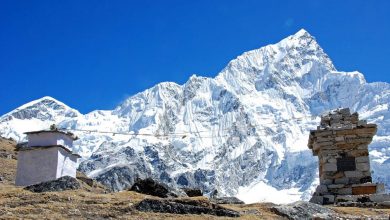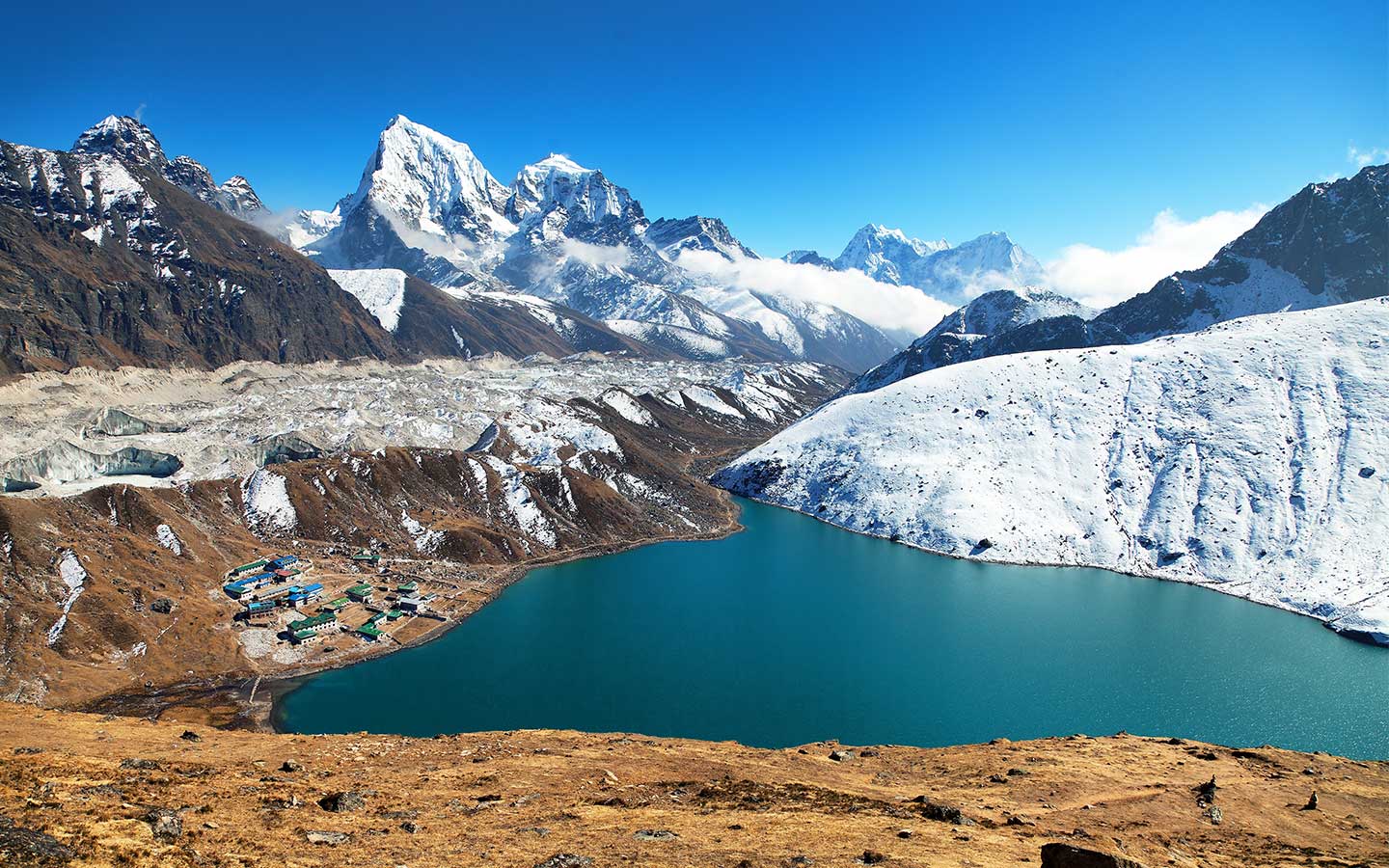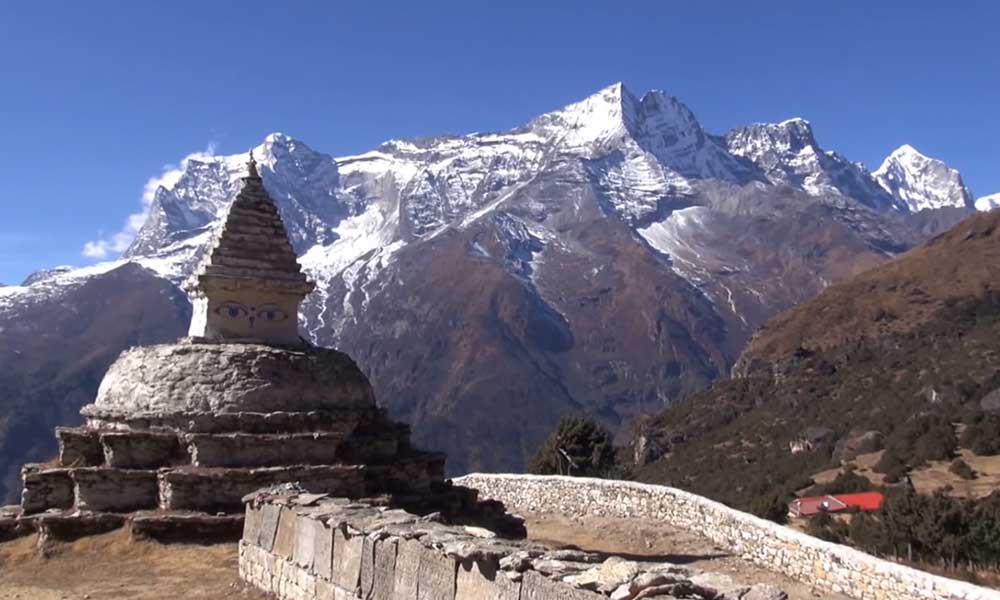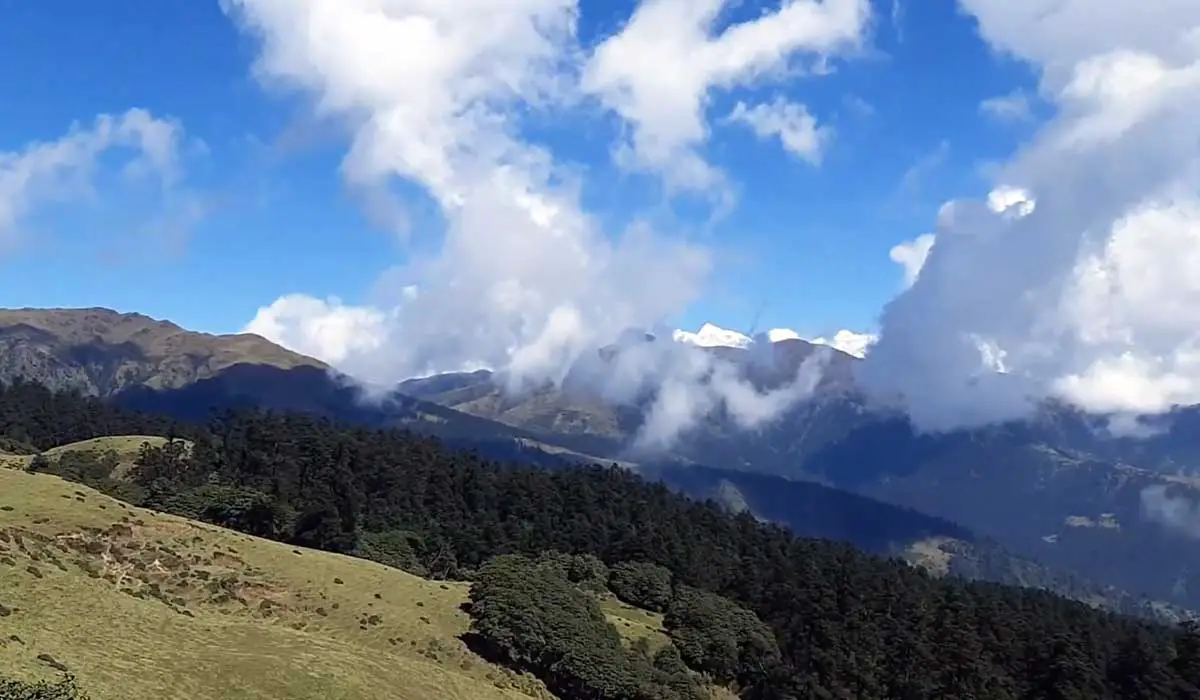Everest High Passes Trek – 17 Days Itinerary
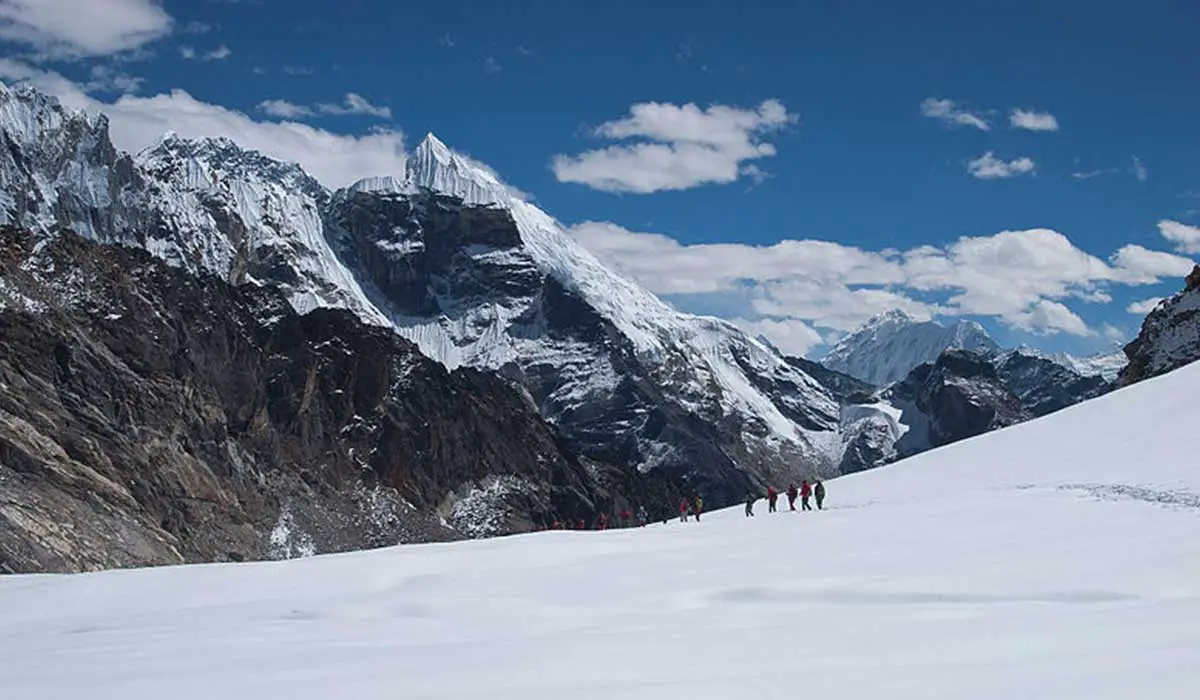
Are you looking for a trekking expedition in the Everest Region but having a hard time deciding which one to choose? With so many trekking activities in the Everest Region, all being tempting, it is hard to choose the best one. Well, we have the Everest High Passes trek also known as the 3 passes Everest Trek which takes you through all the best destinations in the Everest Region.
Instead of taking short treks with a single main destination, why not take the Everest 3 passes trek that gives you an allrounder wholesome trek of the Everest Region without missing anything.
With the Everest High Passes Trek, you get the trek experience of Everest base camp trek, Everest 3 high passes trek, Everest base camp and Gokyo to trek, etc. Basically you get to explore all the best destinations of the Everest region with the 17 days Everest 3 passes trek.
The 3 passes Everest Trek itinerary takes you to the gateway of Everest Region through the scenic Lukla flight. Exploring the famous Namche Bazaar, you will head towards the infamous Tengboche Monastery.
After your visit to the monastery and admiring the beautiful views from the monastery, you will head towards the beautiful settlement of Chhukung. Passing through Chhukung, you will cross the very first high pass of Everest Region and the 3 passes Everest Trek, Kongma La. This pass is at an altitude of 5535 meters.
Crossing one of the first high passes of Everest Region, you will head towards Lobuche and reach Everest Base Camp. Reaching one of the most sought after destinations in Nepal, you can admire the scenes, take some pictures and live the moment. We shall then leave for Gorakshep.
Spending the night in Gorakshep, we will set for another popular destination. The famous viewpoint of the Everest Region, Kalapathar is next on our 3 Passes Everest trek itinerary.
After witnessing the mesmerizing view from Kalapathar, we will leave for yet another high pass of the Everest Region. Chola Pass at an altitude of 5300 meters is next on our destination as we pass through Dzonglha village
Crossing the high pass at Chola, we will even explore the famous Gokyo Ri as we acclimatize in the Gokyo village. Returning from Gokyo, we will cross and explore the Renjo La Pass at the altitude of 5360 meters.
Now that we have visited the three passes, our 3 Passes Everest Trek is about to come to an end. However, we still have some nice places to visit. Crossing the last high pass, we will travel down to Lungden and head to Thame Village. This village is famous for the Thame monastery.
The monastery visit will be great exposure to the lifestyle and culture of the locals. We shall now head back to Namche and return to Kathmandu with the scenic Lukla flight once again. This ends our 17 days Everest 3 Passes Trek.
Everest High Passes Trek Highlights
- Picturesque flight to and from Lukla
- Magnificent views of Khumbu and Ngozumpa Glacier
- Syangboche Airstrip
- Kalapathar Viewpoint
- Three High Passes: Cho La Pass, Renjo La Pass, and Kongma La Pass
- Gokyo Ri
Everest High Passes Trek Best Time
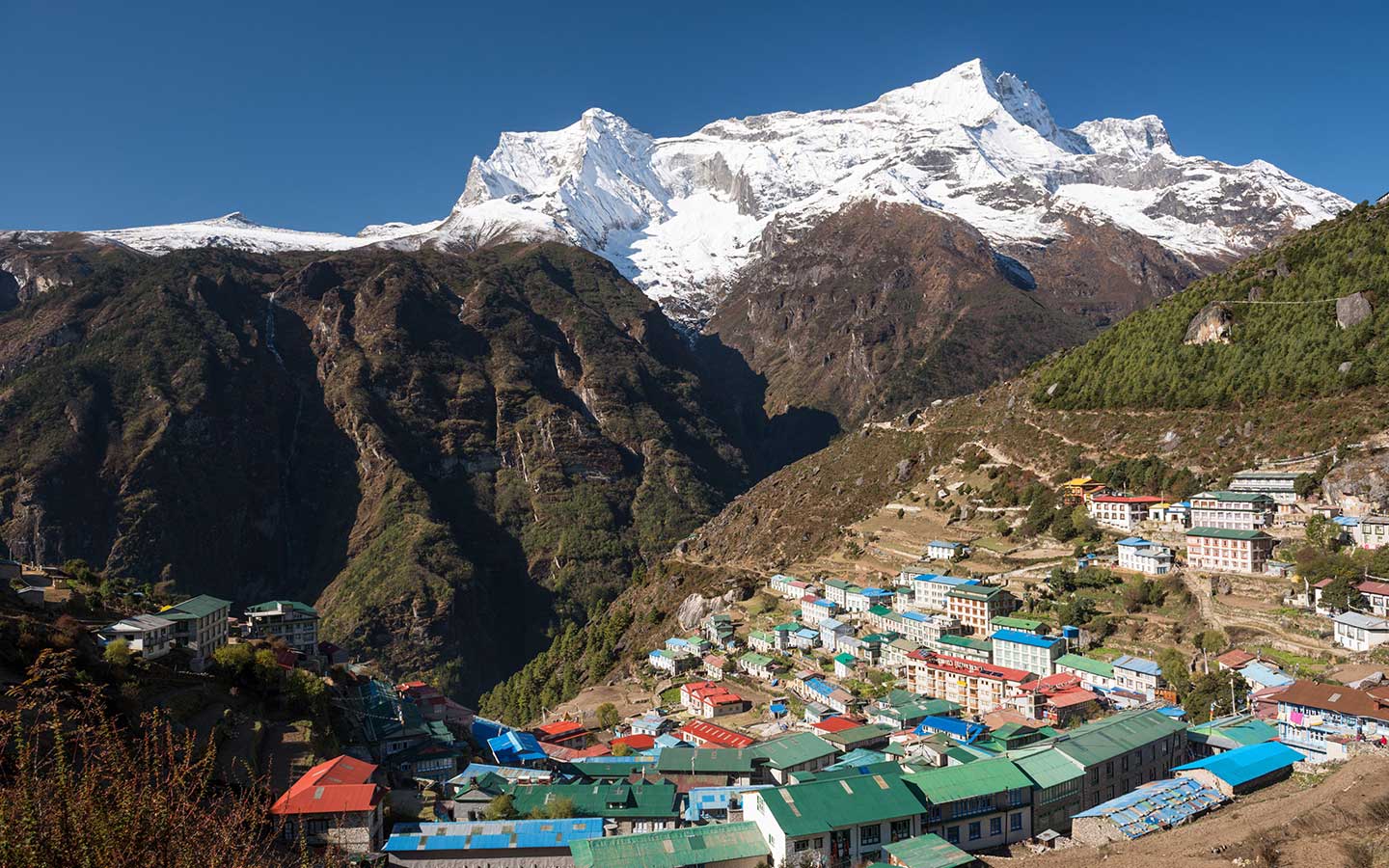
Excited about the allrounder Everest High Passes Trek? Wondering what is the best time for Everest High Passes trek? Well considering the length and the routes of the Everest 3 passes trek, the best time for this trek is the Autumn season. Spring season is the second-best time for embarking on this trek.
The Autumn season lies during the months of September to November. This season provides the most favorable temperature and climate for trekking in the Everest Region. The early September may be influenced by monsoon rain from the monsoon season, so it is better to start your journey during mid or late September, just to be safe. With an average temperature of 20 to 25 degrees during the day, trekking is more fun and comfortable during this season.
Spring season from the months of March to May is considered the second Everest 3 passes trek best time as the season provides you with the best views and other weather conditions as well. With the spring season in full action, you get to see much more exotic flora and fauna out in the open along with clear skies with mesmerizing views.
Winter starts from late November to February. The months of early December are favorable for trekking however, the late December days and nights are freezing cold. February starts getting warmer so you can start your trek in mid- last February for best experience and great views of the snow-capped mountains.
Choosing the best time for your Everest High Passes Trek expedition is very important for having a successful and fun journey. With the above information, you can choose your best time for the trek.
Everest High Passes Trek Difficulties
Everest High Passes Trek is not considered a difficult trek but it is a long trek. With long treks, there may be some difficulties during your trek. Some of the common Everest 3 passes trek difficulties and how to overcome them are mentioned below:
Altitude sickness
Traveling above 4000 meters creates a high possibility of getting altitude sickness. However, altitude sickness is only caused if your body cannot adjust to the high altitude. This means with proper acclimatization, you can avoid this circumstance.
Taking proper rest and slowing down your altitude gain pace helps a lot in avoiding altitude sickness. Also, drinking plenty of water with a proper diet is also important. Avoiding smoking, alcoholic drinks and meat also help in avoiding altitude sickness.
Despite all these precautions, if you are prone to getting altitude sickness, don’t worry. You can get altitude sickness medicines to suppress the symptoms and carry on your trek.
Weather and temperature
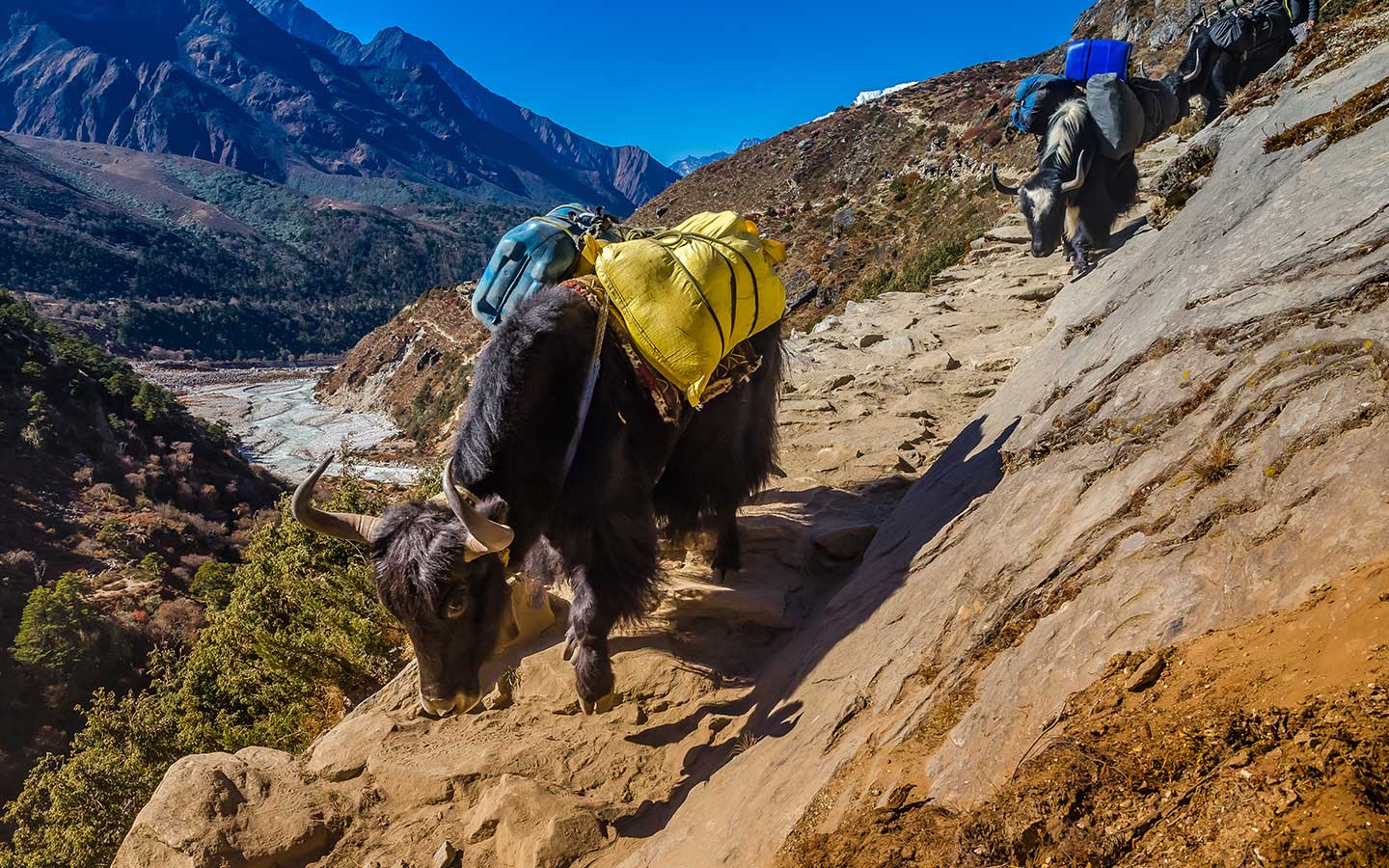
As I have mentioned before, choosing the best time is greatly responsible for the quality of your trekking experience. With the right time to visit the place, you get to see the specialty of the place. If you are someone who loves the snow, you should travel during the colder times. However, this doesn’t mean freezing yourself in the cold. You need to check the weather and temperature and prepare accordingly.
The higher altitudes are prone to unexpected weather changes so keep yourself prepared for everything. The nights are cold so carry warm clothes even in the Autumn season.
Rough routes
Another major difficulty you may face during your 3 passes Everest Trek is that of the rough routes. If you are an experienced trekker, you will have no issues. But if you are a beginner, 17 days Everest High Passes trek may wear you out with the rough terrain and steep climbs.
This means you should prepare yourself accordingly beforehand to improve your stamina and get proper gear to protect yourself from any danger. With quality gear, you can get over the obstacles easily.
Everest high passes Trek Itinerary
Day 01: Fly from Kathmandu – Lukla, and trek to Phakding
Max Altitude: 2860 m
Total Distance: 137 km
Trek Duration: 3-4 hours
Flight Duration: 30 minutes
The first day of our 17 days Everest High Passes Trek Itinerary includes a comfortable and picturesque flight and a short trek. Starting from the capital city, Kathmandu, your trek begins as soon as you board your flight from Kathmandu to Lukla at the Tribhuvan International Airport.
As you board your flight from Kathmandu to Lukla, you will be able to enjoy the picturesque views of the mountains and the landscapes from your flight window. Here’s a little secret: the views from the left side of the flight are the best. You get to comfortably enjoy your flight with live landscapes and mountain views of the region.
You will reach Lukla via flight from Kathmandu in around 30 minutes. Reaching Lukla, you can enjoy the environment and the scenery from there which is completely different from the cityscapes.
You will enjoy your lunch in Lukla and start your first ever trek of the 18 days Everest High Passes trek itinerary. This short trek from Lukla will take you across small streams from Dudh Koshi, across many suspension bridges and narrow paths. The 3-4 hours long beautiful trek will lead you to the village of Phakding. The small settlement area has many tea houses and lodges for your stay.
You will stay overnight at a lodge or tea house in Phakding after enjoying your dinner.
Day 02: Phakding – Namche Bazaar
Max Altitude: 3440 m
Total Distance: 7.4 m
Trek Duration:5-6 hrs
With the morning sun shining upon us, we shall start our day with some breakfast at the teahouse. Today, we shall leave Phakding and head towards Namche Bazaar. Namche Bazaar is a popular destination among almost all trekkers in the Everest Region.
The trail from Phakding to Namche Bazaar is a steep climb with many suspension bridges and rivers. It is going to be an exciting and adventurous day ahead of us. Crossing the Dudh Koshi River many times through the high suspension bridges, we shall enter the Sagarmatha National Park.
Entering the Sagarmatha National Park means getting the opportunity to see exotic flora and fauna. This also means you need the Sagarmatha National Park entry permit and abiding by the rules of the park.
After a long 5-6 hours hiking, we will reach Namche Bazaar, the gateway to Everest Region. Being a popular destination for all the trekkers and a popular market hub for the Sherpas and other merchants, this place is mostly crowded. You will find many interesting items along with great cultural exposure in this region.
You will spend the night at one of the teahouses in Namche Village.
Day 03: Acclimatization Day – Namche Bazaar
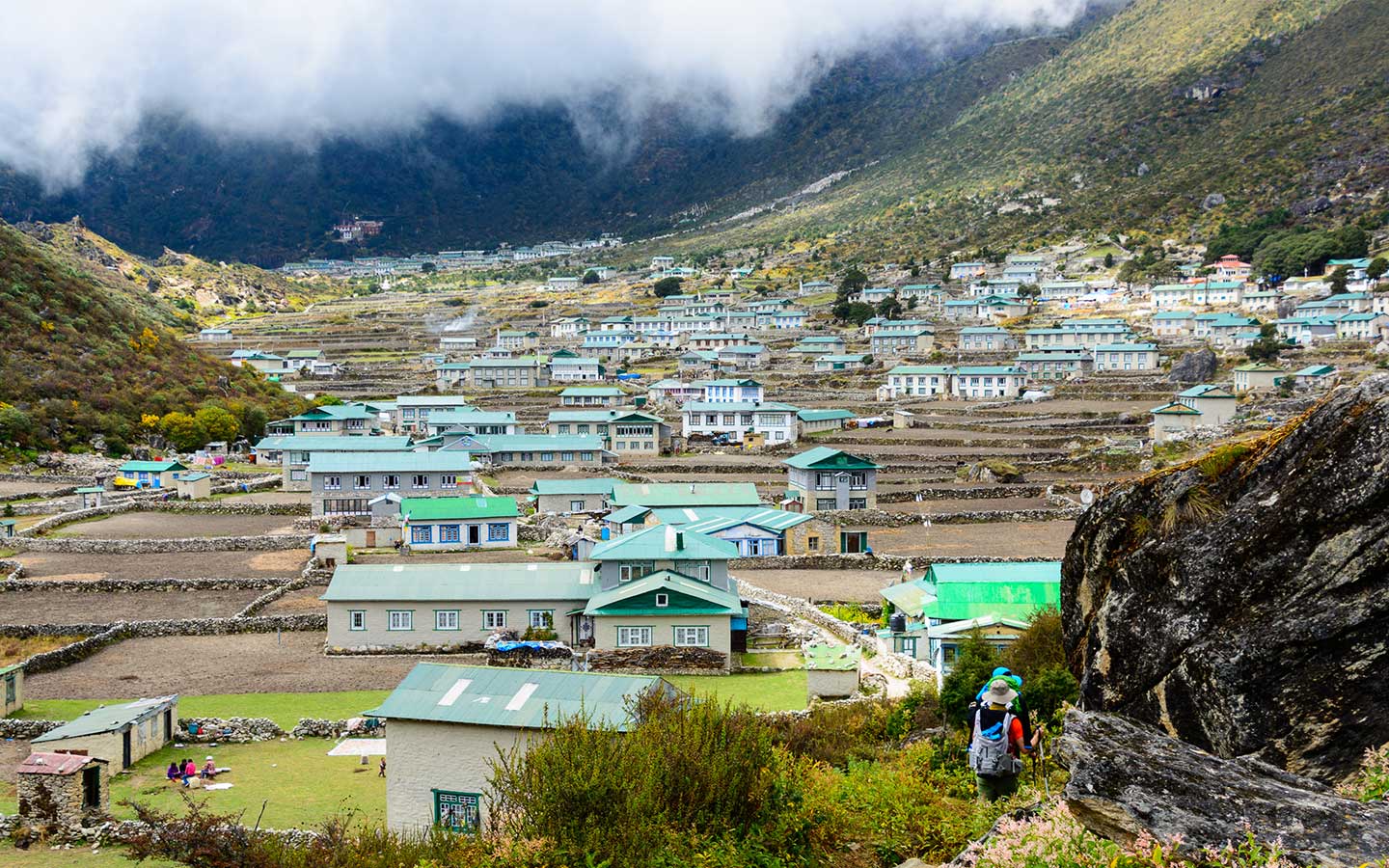
Max Altitude: 3440 m
Total Distance: 500 m
Trek Duration: 3 hours
Today is an important day in our Everest High Passes Trek. Apart from being popular for the marketplace and the cultural influence, Namche Bazaar is also popular as an important acclimatization point in the Everest Region.
Acclimatization refers to providing your body enough time to adjust to the changing higher altitude. Namche Bazaar is an important acclimatization point to avoid any kind of altitude sickness.
Today is not just an acclimatization day, but also an exploration day. You can enjoy the Namche Bazaar and its activities for the day. Acclimatization doesn’t mean staying in Namche the whole day. You can take a short hike to a nearby hill.
From Namche Bazaar, you can take a 3-hour hike to and from Syangboche airstrip. This is a popular viewpoint destination among most trekkers. Even though the airstrip does not run for commercial purposes, it provides great views of the landscapes and the mountains. So the hike is worth it.
Returning back from Syangboche to Namche, you can enjoy the marketplace, get yourselves some souvenirs and try the famous cultural dresses and take pictures. You have a wide range of choices for making the best out of your acclimatization day.
Day 04: Namche Bazaar – Tengboche
Max Altitude: 3860 m
Total Distance: 5.9 km
Trek Duration: 6-7 hours
After letting your body rest and get adjusted to the changing altitude in Namche Bazaar, we shall now head towards Tengboche. As before, the trail to Tengboche from Namche Bazaar consists of many streams, waterfalls and suspension bridges. The path is rough, narrow and steep but has great views of the mountains and the Rhododendron forests.
The trails have a religious vibe to it as you will see many chortens along the way. After a short hike, you will reach Tengboche village. The village of Tengboche is famous for its highly religious and important monastery, the Tengboche Monastery, also known as the Dawa Choling Gompa.
The monastery has great religious and cultural importance in the region. It is a beautiful Buddhist monastery run by the local Sherpas. The Gompa bestows upon you great views of the neighboring mountains. The views of the glorious Everest along with Lhotse, Ama Dablam, and other mountains while the wind rustles the prayer flags hung around the area is a magical sight to see and experience.
Today we will spend the night at a tea house in Tengboche village.
Day 05: Tengboche – Dingboche
Max Altitude: 4410 m
Total Distance: 9.1 km
Trek Duration: 5-6 hours
From Tengboche, we shall leave for Dingboche the very next day. The distance from Tengboche to Dingboche is only 9 kilometers so the trek today will be a short one. You can reach Dingboche from Tengboche in only 5-6 hours.
The altitude reaches above 4000 meters today so make sure to take proper breaks and maintain a slow pace during your trek. This helps in avoiding altitude sickness or acute mountain sickness as the air gets thinner from this point on.
The trail from Tengboche to Dingboche passes through the Imja Valley along with a few other small Sherpa villages. You will get to experience the culture and lifestyle of the locals living in the area. Along with the villages, you also get to see the lush Rhododendron forest paving your way.
Before reaching the Dingboche valley, you will pass through the Pangboche Monastery, another famous destination of the hike. As you reach Dingboche village after a 4-hour hike, you will see the picturesque unique pasture land with buckwheat farming in many fields.
You will spend the night in Dingboche admiring the beautiful landscape and the scenery.
Day 06: Dingboche – Chhukung
Max Altitude: 4750 m
Total Distance: 4.1 km
Trek Duration: 4 hours
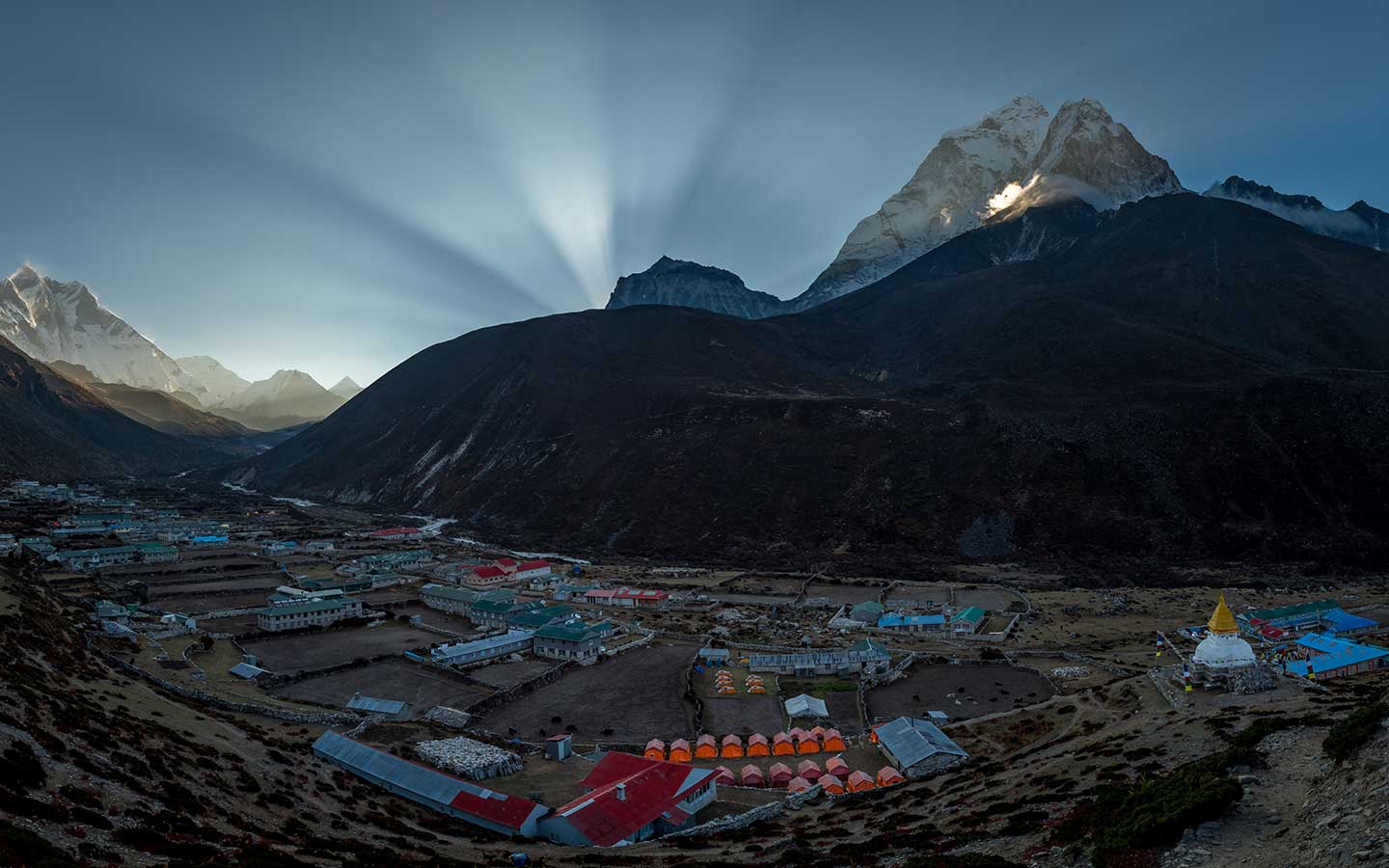
Our next destination is closer to the starting point and the trails are comparatively easier. From Dingboche, we will start our trek to Chhukung early morning after breakfast. The trekking distance is only 9.1 kilometers so we can trek at a slow easy pace.
Reaching above the altitude of 4000 meters, the air gets thinner so it is better to walk slowly. On the way to Chhukung, you will be able to enjoy yourselves with the magnificent views of the alpine landscapes and the Imja river.
Crossing the Imja river, you will trek through the Imja Khola valley. The trail not only provides great views of the alpine vegetation but also the highest peaks like Everest, Island Peak, Lhotse, and Aba Dablam. Apart from the mountains you also get to witness the magnificent views of the glaciers and snow-laden mountains surrounding you. The trail is mesmerizing and the destination is reached within 4-5 hours.
Reaching at an altitude of 4750 meters at Chhukung, you will spend the night at a teahouse in Chhukung.
Day 07: Rest and acclimatization day in Chhukung
Max Altitude: 4750 m
Trek Duration: 4 hours
Today is another acclimatization day for the Everest High Passes Trek. Reaching an altitude of 4750 meters, it is important to have proper acclimatization and let your body adapt to the altitude before going forward. Before heading towards the high passes of Kongma La at 5535 meters, you should let your body rest and adapt.
Today, we will rest in Chhukung but also have a short trek exploring around the region. From Chhukung, you can take a short hike to Nagarjuna hill. This spot is a popular viewpoint destination among the trekkers in the region. With magnificent picturesque views of the neighboring mountains, it is only 3-4 hours away from the Chhukung village.
After enjoying the short hike with beautiful views, you will return to Chhukung village and spend the night here. Rest properly as you will be crossing one of the high passes of 17 days Everest High Passes trek tomorrow.
Day 08: Chhukung – Kongma La – Lobuche
Max Altitude: 5535 m
Total Distance: 7.7 km
Trek Duration: 7 hours
After resting and preparing your body for the trek to Lobuche, we shall leave Chhukung early morning having breakfast. As we leave Chhukung, you take on a steep trail and head towards the northwest of Chhukung. With the Nuptse glacier in a clear view, we will walk past great views of the Amphu Lapcha and Island Peak Valley.
After walking through the great views of the mountains on the steep trails, you will reach one of the high passes of Everest Region, Kongma La Pass at the altitude of 5535 meters. The pass provides the best views of the neighboring mountains, villages, and glaciers. The magnificent views of the Khumbu glacier from the top along with the prayer flags make the Kongma La Pass a popular destination.
Descending from the pass can be a bit difficult so be careful on your way down. Following the Khumbu glacier to the north, you will soon reach Lobuche. You will stay the night at a tea house in Lobuche.
Day 09: Lobuche-Gorak Shep -Everest Base Camp – Gorak Shep
Max Altitude: 5545 m
Total Distance: 12.1 km
Trek Duration: 6-7 hours
We have an adventurous and exciting day ahead of us today. Leaving Lobuche after breakfast we will head towards Gorakshep ultimately reaching the Everest Base Camp at the altitude of 5545 meters.
The trail from Lobuche to Gorakshep is filled with steep climbs through moraine stones and meadows. First of all, you will make the climb to the infamous base camp of Everest Mountain. This is a great feat in itself but that doesn’t end our trek. After around 4 hours, you will reach Everest Base Camp and enjoy your time there for a while.
You shall now make a descent to Gorakshep. From Everest Base Camp, Gorakshep is a short descent of around 2 hours. Be careful on your way down as the descending is slightly more difficult than ascending. You shall spend the night at Gorakshep after your beautiful trip to the Everest Base Camp.
Day 10: Gorak Shep – Kala Pathar – Dzonglha
Max Altitude: 5643 m
Total Distance: 3.5 km
Trek Duration: 4 hours
Today, our 3 Passes Everest Trek itinerary takes us to the famous viewpoint of the Everest Region and ends our trek at one of the high passes of the region.
Our first stop after leaving Gorakshep is Kala Pathar. It is one of the most popular destinations among the trekkers in the Everest Region. With the most mesmerizing views of the Everest mountain along with many other neighboring mountains and the glaciers, this viewpoint has the best views at sunrise. So we will leave early to Kala Patthar. Watching the view of the mountains and the glaciers from the altitude of 5643 meters at Kalapathar, we will take our leave for Dzonglha pass.
From Kalapathar, we will make a descent to Dzonghla at the altitude of 5420 meters. Following the Everest 3 high passes trek route, we will pass many small Sherpa villages on our way to Dzonglha. The path bestows upon you mesmerizing views of the villages and the mountains. After crossing a bridge, you will reach the Dzonglha Village where you will spend the night.
Day 11: Dzonglha – Cho La – Thangnak – Gokyo
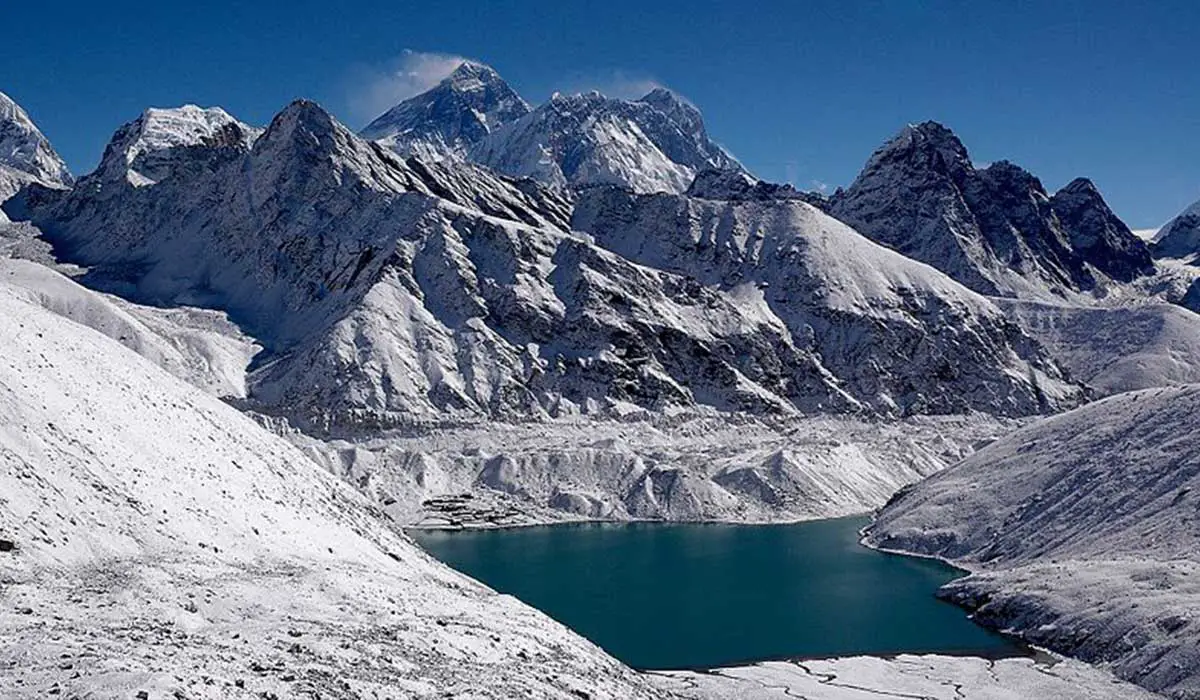
Max Altitude: 5420 m
Total Distance: 8.6 km
Trek Duration: 6-7 hours
From Dzonglha, we shall head towards one of the 3 high passes of Everest Trek. We will leave Dzongla and head towards the Cho La Pass at the altitude of 5420 meters. The route from Dzonglha to Cho la pass is steep so mind your steps during your ascend.
Reaching Cho La Pass, you can enjoy the mesmerizing views of the mountains like Ama Dablam and Lhotse along with the Chola Lake. The way down is a rocky mountainous road. You need to be extra careful while making the descent.
After enjoying the view from the Chola Pass, you will make your descent back to Gokyo Village passing through the Thangnak Village. We will make our descend and have lunch at Thangnak and head towards the Gokyo Village and stay the night at a tea house.
Day 12: Rest and Explore Gokyo Ri
Max Altitude: 4790 m
Trek Duration: 5 hours
Today is another important acclimatization day of our 17 days Everest 3 Passes Trek. along with our acclimatization, we will get some rest for sure but also do some exploration in the Gokyo region.
Today we shall make a short detour to the infamous Gokyo Ri. walking around exploring the Gokyo Ri, we will head towards the tenth Gokyo lake flowing from the Gokyo mountain. This is a beautiful sight to see as the lake flows from one of the high mountains. The region also provides the best views of the mountains like Lhotse, Everest, Cho Oyu and many more.
We shall return back to the Gokyo Valley and rest for the day after we enjoy dinner together
Day 13: Gokyo -Cross Renjo-la pass down to Lungden
Max Altitude: 5360 m
Total Distance: 8 km
Trek Duration: 6-7 hours
After resting up our bodies, we shall head towards the last high pass of the Everest Region for our trek. Leaving Gokyo valley, we will head towards the Renjo La Pass at the altitude of 5360 meters. The trail from Gokyo to Renjo La Pass takes you through the Marlung Village.
Reaching Marlung, you can enjoy the beautiful views of the mountains and the valleys below on a clear day. The path is a descend till the Marlung Village. From Marlung, we will make a steep climb to cross the Renjo La Pass. crossing the Renjo La Pass, you can witness the picturesque view of the Ngozumpa Glacier.
You will now head down towards the settlement at Lungden. Reaching Lungden from Gokyo takes around 6-7 hours. Reaching Longden, you can enjoy dinner and rest at a tea house for the night.
Day 14: Lungden – Thame village(3820m) and visit Thame monastery
Max Altitude: 4380 m
Trek Duration: 4 hours
Our next destination from Lungden is Thame village. As you leave the narrow trails from the Lungden Valley, you will find a small village known as the Thame village after 4 hours of trekking. The village is a small beautiful village popular for its culture and religious activities and great views.
Upon reaching Thame village, you will enjoy your lunch and then head to the Thame Monastery and explore the village a little more before dinner.
Day 15: Thame – Namche
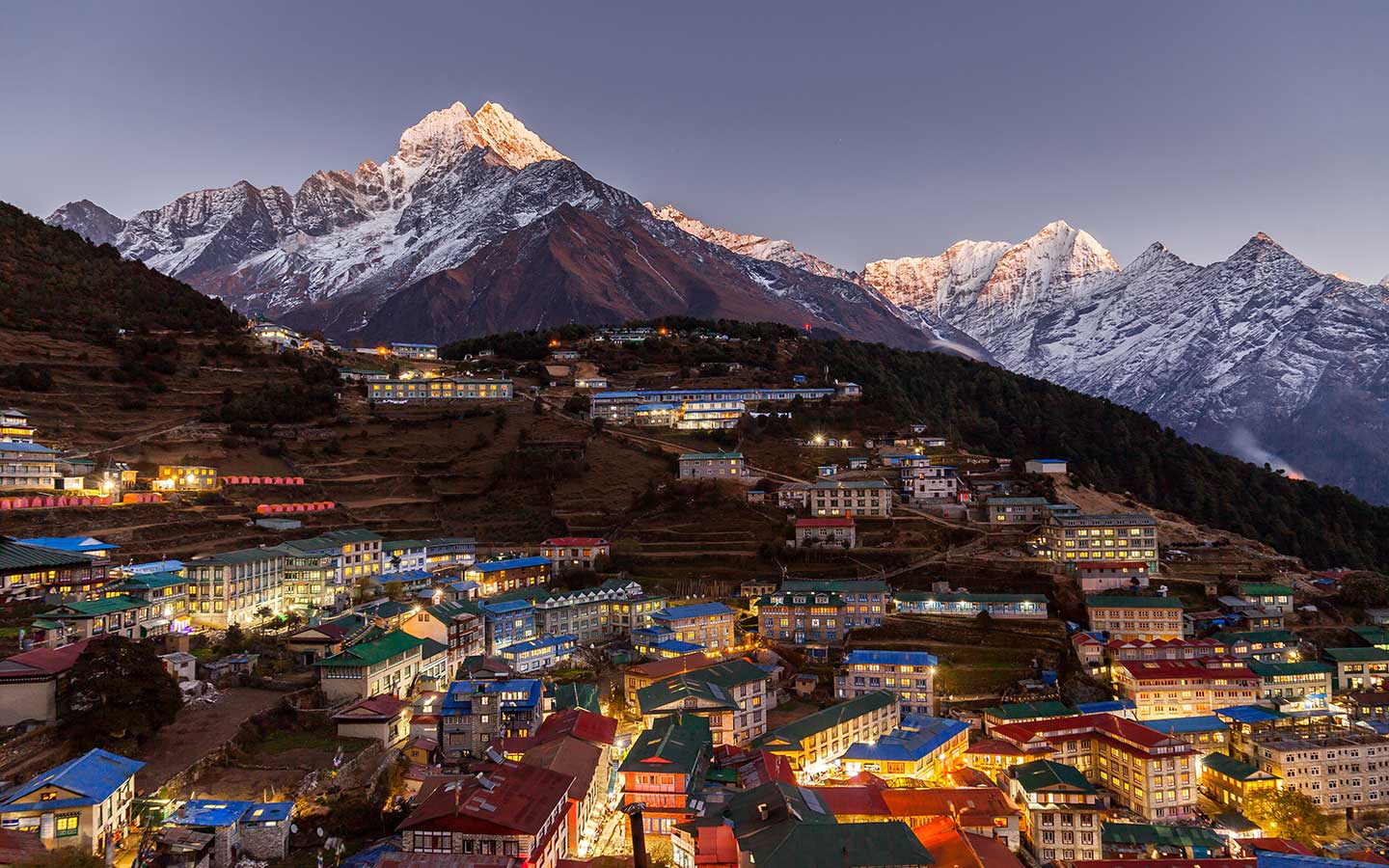
Max Altitude: 3300 m
Total Distance: 8.5 km
Trek Duration: 4-5 hours
Our trek is nearing to its end as we trace our steps and head towards Namche Bazaar once again. After a 4-5 hours trek, you will reach Namche Bazaar. You can enjoy the lunch and explore some more of the beautiful diverse marketplace. You can taste some of the popular bread of Namche Bazaar or Tryon some cultural dresses and enjoy yourselves.
There is only so much you can do before the day ends. We shall spend the night in a teahouse in Namche and head out in the morning after breakfast.
Day 16: Namche – Lukla
Max Altitude: 3440 m
Total Distance: 13.5 km
Trek Duration: 7-8 hours
Today will be our last trekking experience in the Everest Region. Walking from Namche to Lukla is an interesting and thrilling experience. The trails are greener on this side with the Rhododendron forests paving your way. Also, the beautiful views you get to see throughout the trail are a sight to see.
Crossing all the suspension bridges and the streams of Dudh Koshi yet again, you will reach Lukla. This may be a long day for you as trekking from Namche to Lukla is a long 7-8 hours walk covering around 13.5 kilometers distance.
The scenes and the beauty surrounding you makes you forget your trekking distance and fatigue. This is the last trekking day of our Everest High Passes Trek so make sure to enjoy yourselves. Ending the trek at a tea house in Lukla, we shall rest for our last day of the trip.
Day 17: Fly back to Kathmandu
Max Altitude: 2860 m
Total Distance: 137 km
Flight Time: 30 minutes
This marks the very last day of our 3 Passes Everest Trek. As we board our flight back to Kathmandu from Lukla, we will leave with the beautiful memories of the trek in Everest Region for the past 16 days as we admire the picturesque views from our flight.
Reminiscing on the past 16 days of our Everest High Passes Trek comfortably seated enjoying the beautiful views from our Lukla to Kathmandu flight, we will reach Kathmandu in 30 minutes and end our journey together for now.
FAQs
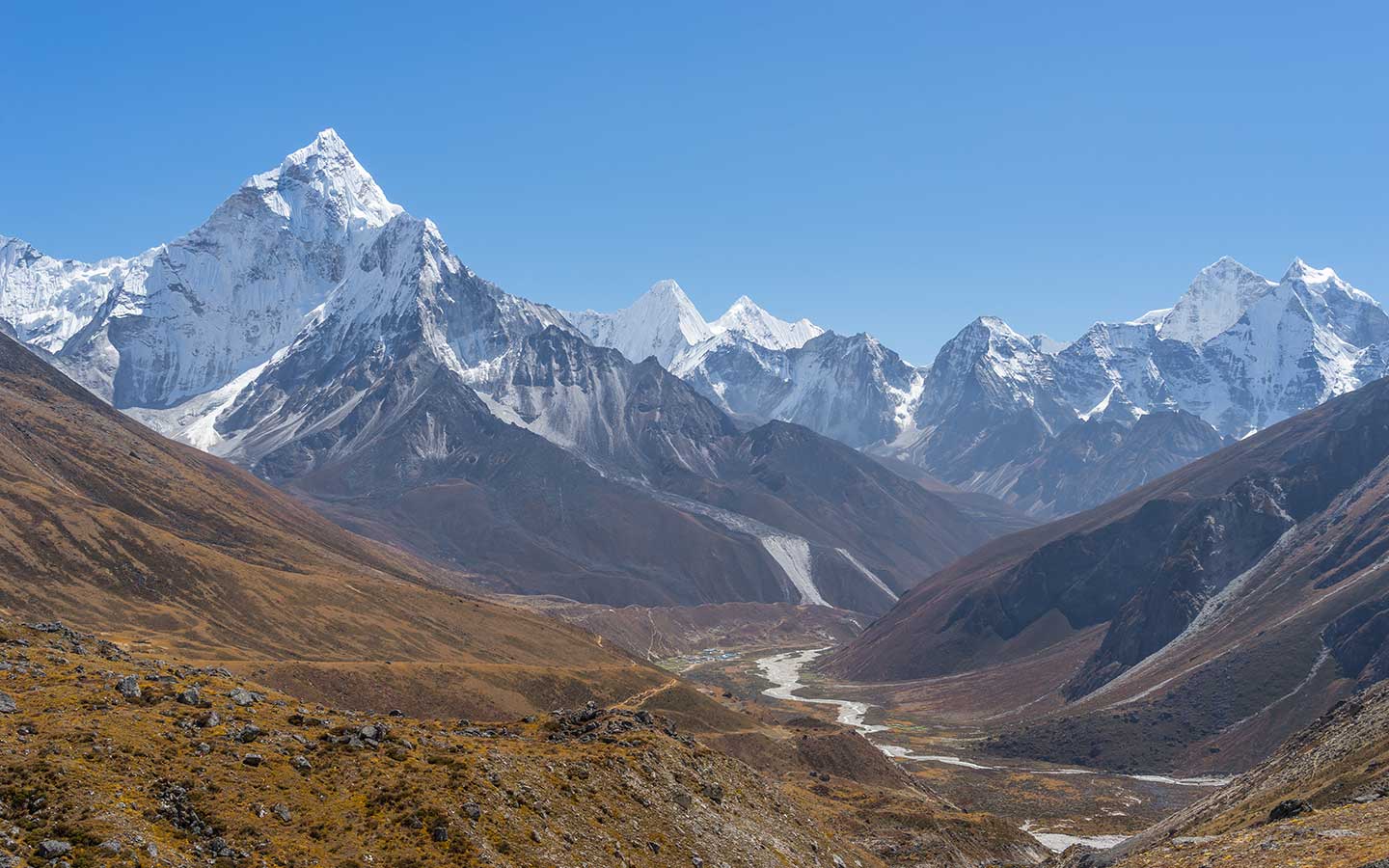
What is the highest altitude of the 3 Passes Everest Trek?
The highest point of the 3 passes Everest Trek is Kalapathar at an altitude of 5643 meters. Apart from that, you will be reaching the Everest Base Camp at an altitude of 5545 meters and the three passes are all above 5300 meters.
Is the Everest 3 passes trek difficult?
The Everest 3 Passes Trek is not very difficult but it is comparatively longer than the Everest Base Camp Trek so you need to prepare accordingly for the trek. The Everest High Passes Trek routes are rough and steep so you should be careful mainly during your descent. Also, one of the major difficulties you may face is the weather so be prepared for uncertain weather conditions in the higher altitudes.
What are the preparations required for the trek?
The 3 passes Everest Trek does not need particular preparations or training. Beginners can also complete this trek easily. However, being in a completely different environment can take a toll on some people so you should prepare yourself mentally before the trek.
Also, having to walk an average of 5-6 hours a day requires stamina build up so some exercises and cardio may help make your trek much easier.
How are the conditions of the Everest 3 Passes Trek routes?
The Everest High Passes Trek routes are not in completely good shape. The trek takes you through off-beaten trails and some steep climbs on the rocky mountains. This means the trail is a bit tough but it does not make it impossible or very difficult. The trail can easily trek with proper guidance and equipment.
What kind of food and accommodation facilities will be provided during the trek?
The food and accommodation facilities during your 3 passes Everest Trek is of moderate quality. You will be provided with the traditional meal 3 times a day and a nice room to sleep in. the conditions of the rooms are moderate. You will get hot showers if you pay extra for the hot water. The room will have an attached bathroom and the beds will be clean. You will not have to worry about the hygiene of the food and accommodation as you will only be provided with the best.
What are the required Everest High Passes trek permits and documents?
The required Everest High Passes Trek Permits are Sagarmatha National Park Entry Permit costing NPR 3000 which is approximately USD 30. Another permit you will need is the Khumbu Rural Municipality Entry Permit costing NPR 2000 approximately USD 20.
In order to get these permits, you will require some documents of your own including passport size photographs for each permit along with your passport with six months of validity.
Are there any tips for beginners?
If you are a beginner to trekking in the Everest Region, I have some tips for you so that you can have a better trekking experience.
- Do some physical exercises to better your stamina before your trek.
- Carry your own water bottle with some water purifier tablets
- Carrying tea bags saves you the hassle and some cash
- You can rent the trekking gears if you don’t want to buy any for the time being
How can I avoid altitude sickness?
Altitude sickness is caused by the change in altitude and your body not adapting to the changing altitude. This can be avoided through proper acclimatization and maintaining a slow pace and taking breaks in between your trek.
Also, a healthy diet and drinking plenty of water are known to be good for avoiding altitude sickness. Avoiding smoking and drinking alcoholic products also help in avoiding altitude sickness. Apart from all these, you can also get medicines that help suppress the altitude sickness symptoms so carrying a few of these tablets helps a ton.
What gear do I need for the trek?
For the 3 passes Everest Trek, you will need some quality trekking boots and the clothing based on the time of the year you decide to embark on your Everest High Passes Trek expedition. You can rent all the gears for the trek from the trekking company if you do not wish to buy any for the time being. However, it is best to bring your own sleeping bags if you need any.
What is considered the Everest high Passes trek the best time?
Autumn and Spring are considered the best time for Everest High passes trek as they provide you with not only the best temperature and weather but also the best views. This includes the months from March to May and the months from September to November. You will get the chance to enjoy the views of the mountains in full glory during these seasons without having to worry about the weather spoiling your plans.
How much do 17 days Everest High Passes trek costs?
The cost of the 17 days Everest high passes trek is based on the services you request and acquire from the company. However, including the transportation and food and accommodation costs, the standard cost of the trek package per person ranges from USD 1650.
After the 17 days, Everest 3 passes trek, you can proudly say that you have traveled all of the Everest Region. We, at TrekEBC, hope that you make great memories at the trek without any issues. We will try our best to provide you with only the best services. You can also contact our company and customize your trek adding or removing days to fit your schedule. We will try our best to fulfill your wishes.
You may also like:
